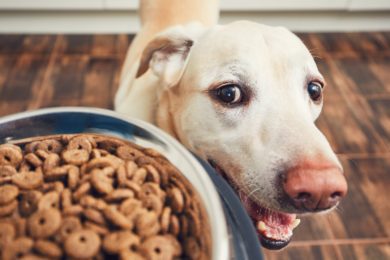Ahhh, the new year. It’s a time for reflection, goal-setting, and attempting to keep resolutions that most of us inevitably forget about by February. It’s the thought that counts, right?
Fear not because our furry friends are here to keep us accountable, remind us of our responsibilities, and push us to be the best pet parents we can be! After all, who needs a gym membership when you have a dog that demands daily walks or a cat that insists on playing at 3 AM? So, let’s make some resolutions and stick to them.

Spending quality time with pets is a fun and rewarding experience and can also positively impact our overall well-being. Whether it’s going for a leisurely walk with your dog, playing with your cat, or simply cuddling on the couch, there are many ways to enjoy quality time with our furry friends. Add an extra 15 minutes to playtime or walks not only to soak up more quality time together but also to encourage you both to keep active.
When you spend extra time with your pet, you can strengthen the bond between pet and owner, reduce stress and anxiety, improve moods, and even lower blood pressure! That sounds like a win-win to us.

Learning pet first aid is an essential skill for any pet owner. Like humans, pets can experience sudden illnesses or injuries, and knowing how to provide basic first aid can save their lives.
In many cases, you may be the only one available to provide immediate help. Knowing pet first aid can help you provide life-saving treatments before you can get your pet to a veterinarian. This can be crucial, especially in emergencies that require quick action, such as when your pet is choking or has stopped breathing.
Taking an online pet first aid course can help you prepare for unexpected situations that may arise, such as natural disasters or accidents. You can also ensure you’re prepared for anything by carrying a pet first aid kit with you on the go. Knowing what to do in these situations can help keep your pet safe and protected.

Neither humans nor pets like to drink from a slimy water bowl or eat from a crusty food dish. And those mysterious stains that appear on pet toys overnight? Let’s not even go there. To kick off the New Year on a hygienic note, start a cleaning schedule for your pet’s belongings because, let’s face it, no one wants to touch a chew toy that’s been marinating in drool.
Start by listing all the items that require regular cleaning, such as toys, food and water bowls, litter boxes, collars and leashes, and bedding. Determine how often each item needs to be cleaned based on its use or level of dirt and odor. For example, food and water bowls should be washed daily or every other day, while toys may only need to be cleaned once a week. Of course, always stick to cleaning products that are safe for pets.
Maintaining a regular cleaning schedule for your pet’s items won’t just keep them smelling fresh and clean, but it’ll also help keep your home spick-and-span.

Listen, we’re not saying your pet needs a full spa day, complete with cucumber slices over their eyes and a seaweed wrap (that would be a pretty cute sight, right?). But, let’s be honest, it can be challenging to cuddle up with a pet that smells like it rolled in something questionable and feels like a Brillo pad.
Grooming your pet is not only essential for your pet’s hygiene and appearance but also for their overall health and well-being. Regular grooming helps to prevent and spot issues early, such as skin infections, matted fur, and ingrown nails. It also lets you identify any lumps, bumps, or skin abnormalities requiring veterinary attention. Additionally, grooming allows for early detection of parasites such as fleas and ticks, which can transmit diseases to both pets and humans.
By keeping your pet well-groomed, you are not only keeping them clean and healthy but also helping them feel their best physically and mentally. You might even find grooming your pet is more relaxing than a day at the spa! Well, maybe not, but at least your pet will be lookin’ their best.

Teaching your pet a new trick can be fun, not just for them but for you, too! It’s always a great time watching your furry friend try to process new information, like when you tell them to “sit” and they look at you like you’ve just asked them to solve a Rubik’s cube. But it’s so rewarding to see them show off their new skills once they catch on.
Start with simple commands and work your way up to more complex ones. This will help your pet build confidence as they learn and make it easier for you to guide them. Be patient and consistent; learning a new trick takes time, so don’t get frustrated if your pet doesn’t get it immediately. And finally, use positive reinforcement. Praise and treats can go a long way in motivating your pet and making the learning process more enjoyable for both of you.
If you’re feeling really ambitious, you could even teach them how to do your taxes – but given the complexity of the US tax code, that might take a while.

When you add that stylish DocuPet tag to your pet’s collar, you join an extensive network of pet owners, neighbors, and community members who all have each other’s back – and of course, their furry friends too. Our HomeSafe™ 24/7 lost pet service aims to reunite your beloved pet with you as quickly as possible by relying on linked tags and online pet profiles.
To ensure a prompt return of your furry pal, we recommend updating your DocuPet profile with the following details:
- Multiple Phone Numbers: Include your home, work, mobile, partner’s mobile, or a trusted friend/neighbor’s contact number.
- Pet Guardians: List the names of anyone who helps with pet sitting or care, such as a partner, neighbor, friend, or dog walker, to act as a secondary contact for your pet if you’re not reachable.
- Pet Description: Describe your pet’s temperament, identifying markings/coloring, and other notable details to help our dispatch team if your pet is ever lost.
- Photos: Uploading photos of your pet makes it easier for the community to recognize and locate them if they are ever reported as lost.
- Feeding Schedule and Vaccination Records: Mentioning their regular eating habits and vaccination records can help a potential finder take care of your pet temporarily and ensure their safety.
- Care Instructions and Vet Information: Including any medical conditions, special accommodations, and vet’s contact details can assist anyone temporarily caring for your pet while working on their safe return.
With HomeSafe™, you have complete control over your pet’s information. You can adjust your privacy settings per your preferences and decide what information to make public and when.

As pet parents, we can all take small steps to reduce our pets’ carbon footprint and help the environment. One of the easiest ways to do this is by using eco-friendly products such as biodegradable poop bags, recycled pet toys, and non-toxic grooming supplies.
One of the easiest ways to reduce your pet’s carbon paw print is through their diet. You can opt for a plant-based diet* or locally sourced food, significantly reducing their carbon paw print. Additionally, walking or biking with your furry friend instead of driving can also make a significant difference in reducing their environmental impact. When it comes to pet toys, look for ones made with upcycled or eco-friendly materials. By taking these small steps, you can make a significant difference in promoting a healthier planet.
*We recommend consulting with your veterinarian before introducing any new foods into your pet’s diet.

There’s never a wrong time to prioritize our pet’s health, but we can sometimes be a little forgetful. Before the year ramps up, get on top of your pet’s vet checkups and appointments now!
Regular checkups with a veterinarian are crucial for maintaining the health and well-being of our furry friends. These appointments allow a professional to thoroughly examine your pet and catch any potential health issues before they become serious problems.
Going to the vet may not be your pet’s favorite activity, but regular checkups are a must. After all, they can’t tell you when something’s wrong, and they don’t have the luxury of scrolling through WebMD.
Setting New Year’s resolutions as a pet parent can significantly improve your pet’s life and strengthen your bond. By committing to things like more exercise, educating yourself on pet first aid and regular vet visits, you can ensure your pet lives a happy, healthy life.
Remember, be easy on yourself if you slip up from time to time. The important thing is that you keep trying and never stop striving to be the best pet parent you can be. May your pet resolutions be as achievable as they are adorable!


